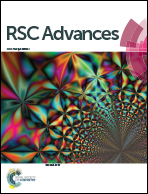Semi-synthesis and anti-lung cancer activity evaluation of aryl dihydrothiazol acyl podophyllotoxin ester derivatives†
Abstract
Lung cancer is the leading cause of cancer death worldwide, making it one of the biggest concerns for chemoprevention. In this study, we obtained seventeen potent anticancer agents through semi-synthesis based on a natural product, podophyllotoxin. Despite prior studies of podophyllotoxin derivatives being focussed on DNA-topoisomerase II, we now turn our attention to their effect on tubulin. The MTT assay screened out the most potent anticancer agent, S12 (IC50 = 0.18 μM against A549 cell line), and it showed lower cytotoxicity against normal cells. Next, the flow cytometry analysis result demonstrated that it can cause a remarkable cell cycle arrest at G2/M phase but the effect on apoptosis is not very significant. In addition, docking simulation results showed that S12 can nicely bound to the colchicine binding site of tubulin. Furthermore, we confirmed that S12 can really inhibit tubulin polymerization through confocal microscopy and protein expression determination assay.


 Please wait while we load your content...
Please wait while we load your content...